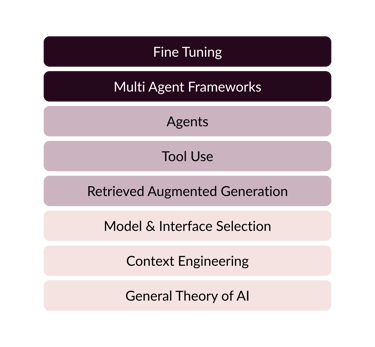

AI literacy ladder
The AI literacy ladder is a learning framework for non technical people to become familiar and productive with generative artificial intelligence
This learning framework is the result of 3 years of learning about generative artificial intelligence and working with groups of non technical across Europe in the domains of healthcare, creative industries, education, public services, and service design.
The framework is constantly adapting as new capabilities are added to generative AI tools and as we understand the needs of people trying to adapt these technologies in their work and life.
It is the result of over 2000 hours of study along with live research and development in beta tests, seminars and workshops all over Europe. You are currently looking at version 4.5 of the AI literacy ladder.
This framework has been developed by Esko Reinikainen
1 General theory
Establishing a basic understanding of how generative AI systems work. How are they made, how do they function, what can they do, what can't they do.
2 Context Engineering
Understanding the basic techniques required to get useful results out of generative AI tools. This includes basic skills in prompt engineering and understanding how you can manage the information environment used by models to get more accurate, productive and safe results.
3 Model & Interface Selection
How do you choose the right model for the right job? What system should you use to make the best use of your selected model? Where is your data being processed? Depending on the context in which you are working and the outcome you are trying to achieve will depend on the choices you make.
4 Retrieval Augmented Generation
At some point you will want to use your own data with AI tools. How do you select the most appropriate method for your specific use case.?
5 Tool Use
Tool use means connecting your AI system to external tools. For example your email, calendar, or a travel booking site. Understand your options for expanding your AI capabilities by connecting to other systems.
6 Agents
Agents are AI systems that can reason, use tools, and autonomously complete a defined goal. Generating agents is much simpler than it sounds and can seriously boost your productivity.
7 Multi Agent Frameworks
Connecting several agents into a system with an 'orchestration' layer that allows you to carry out complex tasks or even automate the execution of a goal by an agent swarm.
8 Fine Tuning
Taking an existing model and refining it further by training it on your data or making it smaller. This can make models more accurate, hallucinate less, and cheaper to run.
